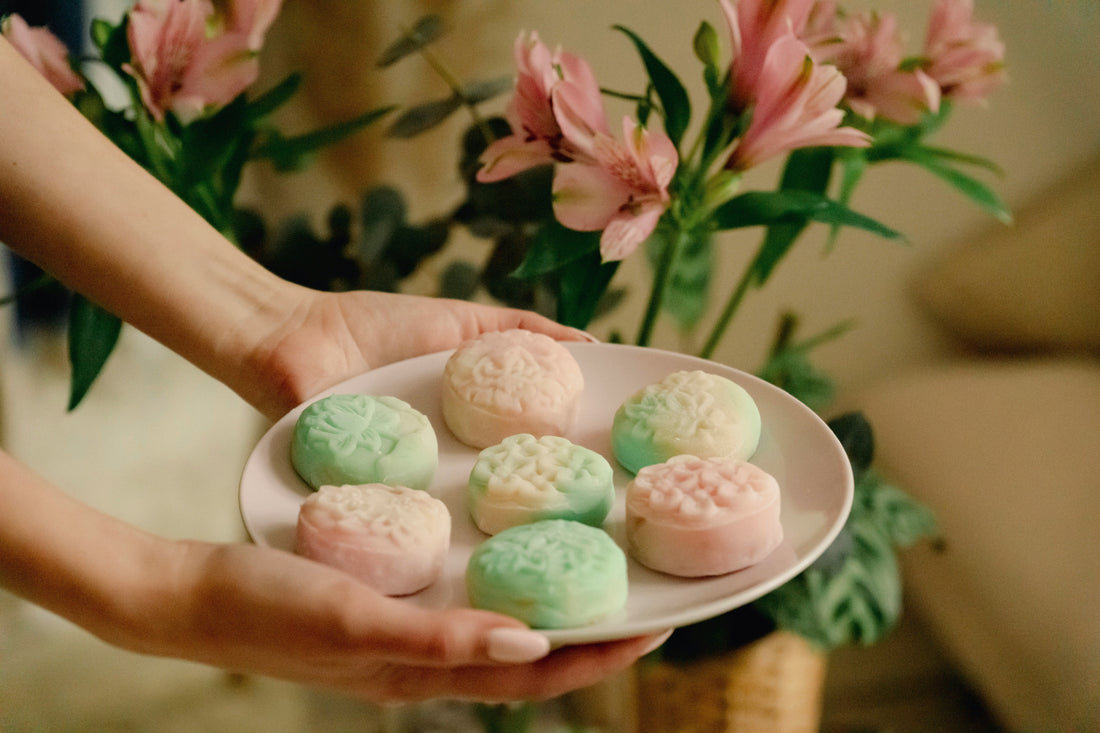
More on Mooncakes!
Share
Hello Tea Friends,
Last year, Angel from our Customer Service team wrote a great blog about Zhong Qiu Jie (中秋節), also referred to as the Mid-Autumn Festival. She did a good job covering its origins, traditions, and all the symbolism tied to it — but she only gave mooncakes one measly paragraph!
Well, no more — I’m here to fix that.
Let’s dig in!
Symbolism
Starting off easy — let’s first talk about the symbolism of the mooncake. As Angel mentioned in her blog, the Mid-Autumn Festival is all about togetherness, unity, and… the moon! What better way to celebrate its uniting light than with tiny little cakes?
Mooncakes are filled to the brim with history and symbolism. (And also, paste.)
These delicate pastries are often divided into segments and shared among family and friends as a way to express affection and best wishes for one another.
And yes, it’s perfectly fine to enjoy them outside of the festival too! Most people don’t, since they’re tied to the festival — but there’s no rule against sneaking one in early or eating a bunch a few weeks after.
Origins
The origins of the mooncake are so fascinating to read about, in my opinion. I’ll give a brief little overview here, but I highly recommend reading more about it yourself.
Mooncakes actually began in a different form known as the Taishi cake, which dates all the way back to the Shang Dynasty. These early cakes were often used as offerings in moon worship rituals. It’s easy to see how they evolved to carry the symbolism they do today.
Things get really interesting around the Yuan Dynasty, though. This dynasty, which lasted from 1271–1368 , was a time when the region was ruled by the Mongols. The mooncakes of that era were just the right size to hide secret messages inside — the perfect way for revolutionaries to plot a rebellion against an empire, all sneaky style.

Photo by Alexa Soh
How pretty are these?
Mooncakes truly rose in popularity as a baked good during the Ming Dynasty, when the legend of Chang’e also became associated with them. Her story was often depicted on the cakes’ surfaces through intricate designs or characters.
If you’d like to read more about Chang’e, check out the Mid Autumn blog from last year, as there's some simplified coverage on it there.
In modern times, the festival has become a bit more formal, as most celebrations tend to over the years. These days, you can find mooncakes in many flavors, each one more unique and flavorful than the last.
Variety!
Like all popular foods, there are quite a number of different varieties a person can make or buy during the holiday season!
Common styles of mooncakes you may see are:
-Mixed Nuts
-Red Bean Paste
-Lotus Seed Paste
-Snow Skin (these ones aren’t baked!)
-Salted Egg Yolk
As they say though, necessity is the mother of invention. What was the necessity in this case? More flavors!!
Some less common and newer flavors you might see are:
-Chocolate
-Green Tea
-Ice Cream
-Cream Cheese
-Seafood
And of course, we can’t forget about the regional varieties! Beijing-style mooncakes are known for their meticulous decoration and delicate sweetness, while Suzhou-style mooncakes are made from layer upon layer of crisp, flaky pastry. In Yunnan, you might come across savory ham mooncakes or fragrant flower mooncakes, and in Chaoshan, larger mooncakes with a distinct crust are the local specialty.
I could go on and on — there are so many yummy sounding varieties out there!

Photo by Jackie Hu
Some more examples of decorations and colors!
Tea Pairings
Unfortunately, I’m not able to eat most mooncakes myself — but that doesn’t stop me from appreciating them! Luckily, there are plenty of recommendations out there for what teas pair best with each type.
Below, I’ll share some of the most popular pairings, along with the teas I’d personally choose from the Teahouse for each one.
-Five-Kernel (Nut) Mooncakes — A ripe pu’er or a red tea pairs wonderfully with these, as the sweet, sticky filling of nuts, seeds, and maltose syrup needs a strong contender to balance it out.
-Creamy Custard or Salted Egg Yolk Mooncakes — These have a rich, velvety filling, so an oolong makes an excellent companion. I’d recommend teas like Eastern Beauty Oolong or Tieguanyin (Iron Goddess of Mercy) for their smooth, fragrant notes.
-Nutty or Mixed-Nut Mooncakes — A bold, full-bodied tea such as a strong oolong or Tibetan Dark Tea will compliment the nutty flavor beautifully, according to the denizens of the Internet.
-Red Bean Mooncakes — Red bean fillings can be quite sweet, from personal experience. Try a tea like Alishan Milk Oolong, which has gentle, creamy notes that balance the sweetness without overpowering it.
-Fruity or Light Snowskin Mooncakes — For these delicate treats, go for a light and fragrant tea like Yangchun Snow Jasmine or Taiwanese Four Seasons Oolong. Their soft floral tones will enhance the sweet, zesty flavors of the mooncake and then follow up by cleansing your palate afterward.
I suppose all that’s left for me to do now is sit here with my tea and daydream about mooncakes, since I can’t enjoy them myself. If you have your own recipes or favorite pairings, I’d love for you to share them over on the Jesse’s Teahouse Discord—far better than trying to sneak recipes to me inside a mooncake!
Until next time, happy steeping!
-Mickey
Cover photo courtesy of Xinyi Wen
